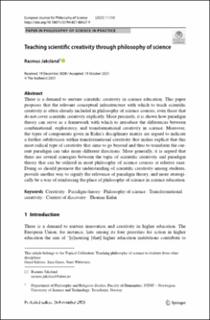| dc.contributor.author | Jaksland, Rasmus | |
| dc.date.accessioned | 2021-12-13T12:55:19Z | |
| dc.date.available | 2021-12-13T12:55:19Z | |
| dc.date.created | 2021-11-26T11:23:12Z | |
| dc.date.issued | 2021 | |
| dc.identifier.citation | European Journal for Philosophy of Science. 2021, 11, 1-17. | en_US |
| dc.identifier.issn | 1879-4912 | |
| dc.identifier.uri | https://hdl.handle.net/11250/2833996 | |
| dc.description.abstract | There is a demand to nurture scientific creativity in science education. This paper proposes that the relevant conceptual infrastructure with which to teach scientific creativity is often already included in philosophy of science courses, even those that do not cover scientific creativity explicitly. More precisely, it is shown how paradigm theory can serve as a framework with which to introduce the differences between combinational, exploratory, and transformational creativity in science. Moreover, the types of components given in Kuhn’s disciplinary matrix are argued to indicate a further subdivision within transformational creativity that makes explicit that this most radical type of creativity that aims to go beyond and thus to transform the current paradigm can take many different directions. More generally, it is argued that there are several synergies between the topic of scientific creativity and paradigm theory that can be utilized in most philosophy of science courses at relative ease. Doing so should promote the understanding of scientific creativity among students, provide another way to signify the relevance of paradigm theory, and more strategically be a way of reinforcing the place of philosophy of science in science education. | en_US |
| dc.language.iso | eng | en_US |
| dc.publisher | Springer Nature | en_US |
| dc.rights | Navngivelse 4.0 Internasjonal | * |
| dc.rights.uri | http://creativecommons.org/licenses/by/4.0/deed.no | * |
| dc.title | Teaching scientific creativity through philosophy of science | en_US |
| dc.type | Peer reviewed | en_US |
| dc.type | Journal article | en_US |
| dc.description.version | publishedVersion | en_US |
| dc.source.pagenumber | 1-17 | en_US |
| dc.source.volume | 11 | en_US |
| dc.source.journal | European Journal for Philosophy of Science | en_US |
| dc.identifier.doi | 10.1007/s13194-021-00427-9 | |
| dc.identifier.cristin | 1959640 | |
| dc.source.articlenumber | 110 | en_US |
| cristin.ispublished | true | |
| cristin.fulltext | original | |
| cristin.qualitycode | 2 | |

